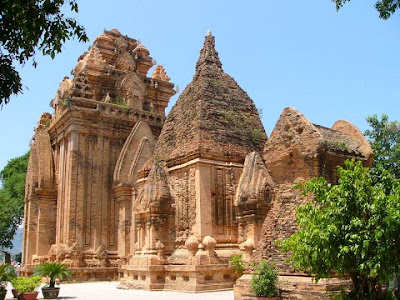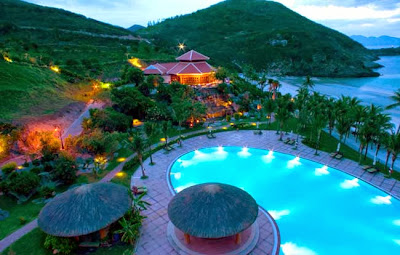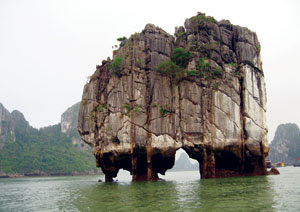Da Nang
Area: 1,283.4 sq. km
Population: 926 thousand habitants (2010)
Administrative divisions:
- Districs: Hai Chau, Thanh Khe, Son Tra, Ngu Hanh Son, Lien Chieu, Cam Le.
- Rural districts: Hoa Vang, Hoang Sa.
Ethnic groups: Viet (Kinh), Hoa, Co Tu, Tay...
Da Nang City is located in middle of Central Vietnam, between Hanoi and Ho Chi Minh City, separated from Laos by the western Truong Son Mountains. It is surrounded by Thua Thien-Hue along the northern border and Quang Nam on the southern border. It is embraced by the East Sea with 150km of seacoast.
Topography is rather complex. The south is impressive Hai Van Pass with Mang Mountain 1,708m, Ba Na Mountain 1,487m. The east is Son Tra Peninsula, an ideal site of yellow sand beaches, historical remains, and rare bird and animal species. The south is Ngu Hanh Son (Marble Mountains). The seashore is Hoang Sa archipelago with a large fishery.
The city itself has neither the atmosphere of Hanoi nor the hustle-bustle of Ho Chi Minh City, but has its share of sights, and is close to the charms of Hoi an and the imperial capital of Hue. Why do they call it the seaside and riverside city? Because Da Nang is a picturesque city by the Han river, and by the coast of the East Sea with distinctive attractiveness in comparison with other sea cities, luring hundreds of thousands of tourists from around the world!
The city is in the site of the East Sea and Han River with special different charms. Nature has offered the city a great position among three World heritages generously: ancient royal capital Hue, ancient city Hoi an and Holy land My Son. Thanks to this, Da Nang plays an important role in hosting, serving and transferring visitors. Not only being in the middle point of three world heritages, but also does it has numerous unforgettable beautiful scenes, such as Han River, Hai Van Pass, Son Tra Peninsula, Ba Na Mountain, Marble Mountains, etc.
Besides the bustle of the city center, there are ancient villages and traditional trade villages hidden by the range of bamboos in the city's suburban areas of Da Nang. Outside the city, Phong Nam ancient village, Tuy Loan ancient village have a vast view of rice fields, small paths under bamboo shade and sometimes feeling peaceful atmosphere of hens' sound in the afternoon. In the village, there still remain the old-aged communal houses through ups and downs of the city history. However, there are sacred holy atmosphere but to be very close to the spirit of Quang Nam and Da Nang people.
Climate:
Da Nang is located in the zone of typical tropical monsoon, temperate and equable climate. The city's weather bears the combination of the north and the south climate characters with the inclination to the former. There are two seasons: the wet from August to December and the dry season from January to July, cold waves are occasional but they are of average and short lasting. Average humidity is 83.4%.
Average temperature is about 260C, the highest is 28-300C in June, July, August, the lowest is 18-230C in December, January, February. In Ba Na Mountain, the temperature is 200C. Average rainfall is 2,505mm per year that concentrates during October and November.
Tourism:
Danang is an ancient land, closely related with the Sa Huynh cultural traditions. Many imposing, palaces, towers, temples, citadels and ramparts, the vestiges from 1st to 13th are still to be seen in Cham Museum
Danang has other various interesting attractions as Ba Na Tourist Resort, Ngu Hanh Son (Marble Mountains) as well as the Linh Ung Pagoda, Han River, and My An, Non Nuoc beaches, stretching on dozens of kilometers...
Transportation :
Road: Danang is 108km from Hue, 130km from Quang Ngai, 763km from Hanoi, and 947km from Ho Chi Minh City.
Air: The Danang International Airport is 2.5km south-west of the city center. There are domestic flights to some cities. There are direct flight from Bangkok, Hong Kong, Siem Riep, Taipei and Singapore to Danang City by Vietnam Airlines, PB Air, Siem Riep Air way, Far Transportasion and Sil Airway.
Train:Thong Nhat Express train, which connects Hanoi and Ho Chi Minh City, stop in Danang.
Water: There are marine routes to international and domestic ports. Tien Sa and Han River ports are located in a very wonderful position.

















































